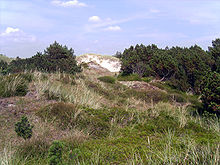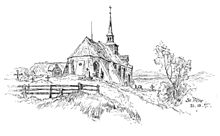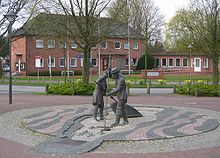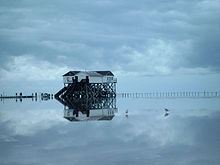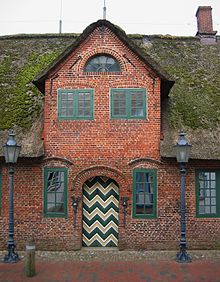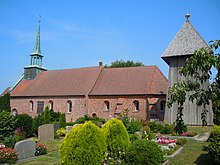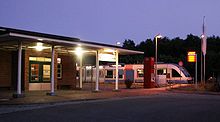Sankt Peter-Ording
| coat of arms | Germany map | |
|---|---|---|

|
Coordinates: 54 ° 18 ' N , 8 ° 39' E |
|
| Basic data | ||
| State : | Schleswig-Holstein | |
| Circle : | North Friesland | |
| Office : | Eiderstedt | |
| Height : | 3 m above sea level NHN | |
| Area : | 28.32 km 2 | |
| Residents: | 3997 (Dec. 31, 2019) | |
| Population density : | 141 inhabitants per km 2 | |
| Postal code : | 25826 | |
| Area code : | 04863 | |
| License plate : | NF | |
| Community key : | 01 0 54 113 | |
| LOCODE : | DE PSH | |
| Office administration address: | Welter Strasse 1 25836 Garding |
|
| Website : | ||
| Mayor : | Rainer Balsmeier ( independent ) | |
| Location of the municipality of Sankt Peter-Ording in the district of North Friesland | ||
Sankt Peter-Ording ( North Frisian St. Peter-Urdem ) is a municipality in the district of North Friesland in Schleswig-Holstein . It is the only German seaside resort to have its own sulfur spring and is therefore known as the “North Sea Health and Sulfur Bath”. According to the number of overnight stays, Sankt Peter-Ording is the leading seaside resort in Schleswig-Holstein.
geography
Geographical location
Sankt Peter-Ording is located in the southwest of the Eiderstedt peninsula in Schleswig-Holstein . Part of the district is located in the Schleswig-Holstein Wadden Sea National Park .
Community structure
The municipality of Sankt Peter-Ording has four districts - Böhl, Bad, Dorf (south) and Ording. Occasionally, Brösum an der Tümlauer Bucht is mentioned as the fifth district.
Neighboring communities
Directly adjacent municipal areas are:
| Tümlauer Koog | ||

|
Tating | |
geology
The spacious beach is characteristic of Sankt Peter-Ording . It extends over a length of up to twelve kilometers and (at low tide) up to two kilometers wide in the west of the town. Its size has historically arisen from the landing near the coast of two sandbanks, the hot and high- visibility sand , on the mainland. These were among the so-called outer sands of the North Frisian Wadden Sea that still exist today . This is followed by a belt of dunes in the central section of the coast in front of the Bad district . Atypical for this region, it was subsequently forested. The highest natural elevation in the municipality, Maleens Knoll, is located here at 16.6 meters above sea level .
In front of the St. Peter-Böhl district to the south, a salt marsh landscape has developed. Since they were neither grazed nor provided with groups , they have a special ecological meaning. In contrast to other salt marshes on the North Sea coast, there are numerous small pools and puddles here. In the land surrounding part they are only occasionally and not even flooded every year by salt water, so here that - now unusually directly into the North Sea - amphibians such as frog , moor frog and toad have settled and toads breed regularly.
The tidal range is up to three meters on site.
climate
As is typical for coastal regions, Sankt Peter-Ording has a maritime climate with mild winters and cool summers. Wind speeds of 7 to 10 are not uncommon.
The island climate, especially the air on the dunes and on the beach, that of the salt marshes and that of the forest, contain substances containing salt , iodine and aerosols . In addition, the low allergen content ensures clean air.
These special properties and the climatic interactions are used for thalassotherapy .
A stay in Sankt Peter-Ording should strengthen the metabolism and the cardiovascular system and stimulate the body's own cortisone production.
history
Sankt Peter-Ording is made up of several formerly separate districts. The name of the village of St. Peter is first mentioned in a document from 1373. The place was previously called Ulstrup. The name of the Church of St. Peter was later used as a place name because Ulstrup had lost a lot of land to the North Sea. There is evidence that the Vikings settled in this area. Süderhöft / Böhl gave up its independence after the storm surge of 1553 and was united with Sankt Peter.
Ording and Sankt Peter were churchly united as early as 1867, while the municipal merger to Sankt Peter-Ording did not take place until January 1, 1967. On April 26, 1970 the community became part of the new North Friesland district. Until then, it had belonged to what was then the Eiderstedt district.
Due to the constant flight of sand, fishing could never establish itself in Sankt Peter-Ording, as no port could be created due to the drifts. Agriculture, on which the population at that time lived, often did not yield enough, as the lands were often salinated or silted up by flooding.
In earlier times were after the flood beach robbers who, Hitzlöper be observed. They searched the flotsam for anything useful. Valuable items were often withheld from the beach bailiff because of the taxes required.
In particular, the shifting dunes used to bother the residents. The orders had to give up their church twice after having had to regularly shovel their way to church services for decades. Planting began in 1860 on the instructions of the Danish king, who ruled over the Duchy of Schleswig until 1864 . At that time the border was formed by the river Eider . After the Austro-Prussian War from 1867, the district of Sankt Peter belonged to the Prussian province of Schleswig-Holstein .
The first beginnings as a seaside resort began in 1877 when the first hotel was built. In 1913 the first sanatorium was built. Half a century later, more rehabilitation facilities were built after a strong iodine brine spring was found in 1953 and in 1958 it was officially recognized as a North Sea spa and sulfur bath.
The first of the characteristic pile dwellings on the beach was built in 1911 and was called " Giftbude " because there was wat gift ("something") there. Among connoisseurs, it meant cognac in particular. The transport connections have also been gradually improved. The first pier on Ordinger Strand was built in 1926, followed by a railway line to Husum in 1932 . A better road connection was made possible by the construction of the Eider Barrage .
St. Peter-Ording was the location of several film and television productions, including Jan Delay - Somehow, Somewhere, Sometime , Scooter - One (Always Hardcore) , Against the Wind , The Hunt for the Amber Room and Now or Never . In 2011, outdoor shots for the film Rubbeldiekatz (directed by Detlev Buck ) were shot in the Bad an der Seebrücke district ; around 200 extras were used.
politics
Community representation
The municipal council election on May 6, 2018 in Sankt Peter-Ording led to the following result (with a difference to the 2013 election):
| Party / list | Share of votes | +/-% p | Seats | +/- |
| CDU | 45.2% | + 7.3 | 8th | + 1 |
| SPD | 24.6% | - 4.0 | 4th | - 1 |
| FDP | 10.0% | + 0.1 | 2 | ± 0 |
| AWG * | 20.1% | - 3.4 | 3 | - 1 |
* General voter community Sankt Peter-Ording
Boy Jöns (CDU) is again the mayor for the 2018–2023 electoral period.
mayor
The full-time mayor is the non-party Rainer Balsmeier.
coat of arms
The coat of arms and flag were approved on July 11, 1967.
Blazon : “In blue two diagonally crossed golden keys with the beards facing away from each other facing upwards; between the key beards on the right a six-pointed golden star and on the left an inwardly turned golden crescent moon next to each other. "
The content of the coat of arms of the parish of St. Peter-Ording, located in the west of the Eiderstedt peninsula, formed in 1967 from the two predecessor parishes of the same name, which is now a well-known seaside resort, takes up the figures of the parish seal of St. Peter. On the oldest seal of the parish from 1376, the place names "Ulstorp" and "Utholm" can be read next to the symbols. Originally the church dedicated to St. Peter was on the island of Utholm. The village name "Sunte Peter" appears for the first time around 1438. The current district of Ording is first mentioned around 1445 as "Urden". The attributes of the apostle , the keys, also refer to the patron saint of fishermen. In the past, sea fishing fed many of the town's residents. The blue shield color refers to the immediate location on the North Sea, the gold of the figures on the beach. Blue and gold are also the colors of the Schleswig region.
The coat of arms was designed by the Brunsbüttel heraldist Willy "Horsa" Lippert .
flag
The flag shows the keys, the star and the crescent moon as in the coat of arms in the leech of a blue field, which is bordered at the top and bottom by a very narrow white and a somewhat wider red stripe.
Culture and sights
Landmarks are the stilt houses on the approximately twelve kilometer long sandy beach and the lighthouse in Sankt Peter-Böhl .
St. Peter-Ording has a modern leisure and adventure pool with a large sauna area - the Dünen-Therme. It is operated with water from the North Sea, spread over more than 1000 m² of water.
There are around 1,400 beach chairs at the five bathing areas Böhl, Süd / Dorf, Bad, Ording and FKK / Ording-Nord. Wireless LAN access that requires registration is available via “hotspots” in the Ording beach chair area and in parts of the beach car park from Easter to the end of September .
In the district of St. Peter-Bad, a 1095 meter long promenade (also known as a beach or pier) leads from the dike to the stilt house “Noah's Ark”. This is to be expanded in the future to include several attractions, such as a fitness and motor skills area, themed playgrounds, a biotope that can be experienced and a “family meeting place” (a playhouse for all seasons).
Sankt Peter-Ording is also the starting point for the Wikinger-Friesen-Weg theme cycle path , which follows the former trade route of the Vikings and Frisians to Maasholm on the Baltic Sea.
Parks
In the "West Coast Park" there is a seal enclosure (Robbarium). The "TaNaGa" (Rigging Nature Garden) is a rope course with balance, climbing and logic elements.
Museums and exhibitions
The Eiderstedt Landscape Museum and the North Sea Amber Museum are located in St. Peter-Ording . In addition, an exhibition on the Wadden Sea with eleven saltwater aquariums can be visited in the National Park House of the Wadden Sea Protection Station .
Exhibitions from the community's extensive art collection can be viewed in the Wittendün art house. Every year in July and August, the Sankt Peter-Ording art initiative presents an art exhibition in the Hungerhamm beach chair hall.
Sports
Sankt Peter-Ording, together with Sylt, is considered the best German area for windsurfing and kitesurfing . Ordinger Strand has a designated water sports zone with a training center. The beach is also used for sand sailing and kite buggy rides . Many kites can often be seen on the dunes . From 2006 to 2015, the ten-day Kitesurf World Cup , a highlight of the Kitesurf World Championships, was held annually on the beach in Sankt-Peter-Ording ; with over 130,000 spectators and more than 100 participants the largest kitesurfing event in the world. The event moved to Fehmarn in 2016. The Beach Volleyball Masters are also held regularly in St. Peter-Ording. Furthermore, the Against the Wind Triathlon takes place every summer (since 2004).
education
The following schools exist in the municipality:
- Utholm School (elementary school), Kirchenleye (158 students in 9 classes)
- North Sea School (grammar school with community school, European school), Pestalozzistraße (683 students in 31 classes)
Student numbers from the school year 2018/2019.
- North Sea boarding school (grammar school with community school, private school), Pestalozzistraße (106 students)
Former schools:
- Danish School Klitskolen (closed in 1984)
- West Coast School (Realschule / from 2010 amalgamated with the North Sea High School)
Economy and Infrastructure
In 2017, the municipality was one of the most important centers for tourism in Schleswig-Holstein : With a total of 1.361 million overnight stays, the municipality was in second place on the North Sea coast of Schleswig-Holstein and third in the whole of Schleswig-Holstein. This year 17,000 guest beds were available.
Numerous diseases can be treated here on an outpatient or inpatient basis, including in rehabilitation clinics.
train
St. Peter-Ording is the end of the Husum – Bad St. Peter-Ording railway line . This route is served by the SH regional train for passenger transport and runs every hour in both directions from early in the morning until around midnight . There are two train stations operated by DB , Bad St Peter Süd and Bad St Peter-Ording .
bus
The local bus connects all parts of the village with each other and can be used free of charge with the guest card.
The following connections are offered from April to early November:
- Line 1: Böhler Strand - Ording train station - Brösum
- Line 2: Brösum - Ording train station - Böhler Strand
- Line 3: Marktplatz - Bad / Zentrum - Marktplatz (Cityshuttle / Citybus)
During the rest of the time, the following connections are offered:
- Line 1: overpass Böhler Strand - Ording train station - Brösum
- Line 2: Brösum - Ording train station - Böhler Strand overpass
During this time the beaches are not used due to the risk of flooding.
Streets
The B 202 from Sankt Peter-Ording via Tönning - Rendsburg - Kiel - Oldenburg in Holstein to the A1 connects the town with the federal trunk road network.
The L 33, L 305, L 153 and B 203 also connect Sankt Peter-Ording via the Eider Barrage and Wesselburen with Heide and thus with the A 23 .
bicycle
St. Peter Ording is connected to the North Sea Coast Cycle Route (the European EuroVelo cycle route runs once around the entire North Sea through six countries).
Airfield
Personalities
Sons and daughters of the church
- Jakob Peters (1873–1944), animal breeding director and cattle breeder
- Alwin-Broder Albrecht (1903–1945), naval officer, one of Adolf Hitler's adjutants during the Second World War
- Jürgen Feddersen (* 1944), politician
- Peter-Olaf Hoffmann (* 1947), local politician, mayor of Dormagen
- Uwe Carstens (* 1948), political scientist and sociologist
- Dietrich Ebert (* 1948), illustrator and graphic designer
Associated with Sankt Peter-Ording
- Fritz Wischer (1869–1949), Low German writer, lived here
- Henry Everling (1873–1960), member of parliament and senator in Hamburg, honorary citizen of Ording 1953
- Friedrich Karl Gotsch (1900–1984), painter and graphic artist, lived here since his release from British captivity and from 1946 to 1948 ran a painting school as a branch of the building group
- Erich Duggen (1910–1989), painter, lived here
- Knut Kiesewetter (1941–2016), jazz musician, attended the North Sea High School
- Doris Kunstmann (* 1944), actress, attended the North Sea boarding school
- Jürgen Koppelin (* 1945), long-time member of the Bundestag (FDP), lives here
- Ursula Sassen (* 1947), politician, lives here
- Iris Berben (* 1950), actress, attended the North Sea boarding school
- Jennifer Nitsch (1966–2004), actress, buried here
literature
- AG Orts-Chronik, St. Peter-Ording (Ed.): St. Peter and Ording in the course of change. Historical views from 1890–1935. St. Peter-Ording 1990.
- C. Müller: Anniversary guide through the North Sea resort of St. Peter-Ording. 2nd edition Hans Christians Verlag, Hamburg 1927.
- Uwe Carstens: The refugee camp St. Peter-Böhl. In: Yearbook for East German Folklore. N. G. Elwert Verlag, Marburg 1988, ISBN 3-7708-0887-8 .
- Werner Klose (editor): 100 years Bad Sankt Peter-Ording. From bath cart to spa treatment. St. Peter-Ording 1977.
- Werner Klose (Ed.): St. Peter-Ording. North Sea spa and sulfur bath. Lühr and Dircks, 1981, ISBN 3-921416-15-9 .
- Heiko Gauert (1996–2002), Georg Panskus (2003–2011 in book form): Yearbook St. Peter-Ording. Fresenborg Publishing House. From 2012 only on the Internet: www.jb-spo.de.
Web links
- Sankt Peter-Ording parish
- Sankt Peter-Ording Tourist Office
- Yearbook St. Peter-Ording
- Chronicle of St. Peter-Ording
Individual evidence
- ↑ North Statistics Office - Population of the municipalities in Schleswig-Holstein 4th quarter 2019 (XLSX file) (update based on the 2011 census) ( help on this ).
- ↑ Nordfriesland map, Bredstedt / Braist 2011, ISBN 978-3-88007-371-5
- ↑ Schleswig-Holstein topography. Vol. 8: Pölitz - Schönbek . 1st edition Flying-Kiwi-Verl. Junge, Flensburg 2007, ISBN 978-3-926055-89-7 , pp. 247 ( dnb.de [accessed on July 23, 2020]).
- ↑ a b Uwe Dierking: The natterjack toads in the foreland of St. Peter-Ording. In: Federal Environment Agency and national park administrations of Lower Saxony Wadden Sea / Schleswig-Holstein Wadden Sea (ed.): Wadden Sea Environment Atlas . Vol. 1: North Frisian and Dithmarsch Wadden Sea. Eugen Ulmer, Stuttgart 1998/1999, ISBN 3-8001-3491-8 , pp. 130-131.
- ^ NDR: Preliminary final result of the municipal council election on May 6, 2018 in Sankt Peter-Ording , accessed on January 1, 2020
- ↑ a b Schleswig-Holstein's municipal coat of arms
- ↑ Investment worth millions! St. Peter-Ording gets special promenade mopo.de , July 24, 2019, accessed on July 26, 2019
- ↑ https://buecherei-spo.de/kunstinspo/
- ↑ Beetle Kitesurf World Cup 2012 St. Peter-Ording ( page no longer available , search in web archives ) Info: The link was automatically marked as defective. Please check the link according to the instructions and then remove this notice.
- ↑ Statistical Office for Hamburg and Schleswig-Holstein: Directory of general education schools in Schleswig-Holstein 2018/2019.
- ↑ https://www.nordsee-internat.de/gemeinschaft.html accessed on February 28, 2020
- ↑ Sparkassen-Tourismusbarometer Schleswig-Holstein - Annual Report 2018. (pdf) Accessed on August 11, 2019 .
- ↑ Tourist development concept for St. Peter-Ording. (pdf) Accessed March 10, 2020 .
- ^ NDR: North Sea Coast Cycle Route in Schleswig-Holstein. Retrieved May 23, 2017 .




